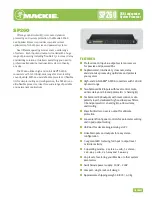
User Manual
BCM1250/BCM1125/BCM1125H
10/21/02
B r o a d c o m C o r p o r a t i o n
Document
1250_1125-UM100CB-R
Section 4: System Control and Debug Unit
Page
79
R
EADING
THE
T
RACE
B
UFFER
Each entry in the trace buffer is 384 bits, and falls in to one of two possible formats. Format 1 is used when the
entry contains one to three address/control samples, the first bundle (t0) will always come from an address
trigger (the ATRIG bit will be 1) and will indicate format 1 by not having an associated data sample (the DTRIG
bit will be 0). Note that if the sample was forced by an all-bus-cycle trigger, a data trigger or to avoid the inter-
sample interval count overflowing, the Avalid bit may be clear indicating the A-phase information is invalid. The
Dvalid bit indicates if there was databus activity when the sample was taken and the D-phase information is
valid. Format 2 covers the address and data sample, in this case there may or may not have been an address
trigger (ATRIG could be either 0 or 1) but there will always have been a data trigger (DTRIG will be 1). Again
the Avalid and Dvalid bits in the control bundle indicate what activity was on the bus and thus which fields of
the sample are valid. Software or the JTAG probe must perform six reads to collect the entire sample before
decoding it.
describes the entry formats and the order in which they are read.
When all the entries have been read from the buffer the ATRIG and DTRIG bits are forced to zeros in any
subsequent reads. This condition can be used to terminate reading the buffer, or the trcFull and trcAddr fields
of the
trace_cfg
register can be used to compute the number of entries that should be read. The startread bit
in the
trace_cfg
register must be written with a 1 before the trace can be read out. The buffer can only be read
out once, any additional attempts will return UNPREDICTABLE data.
Table 50: Trace Entry Format and Read Order
Bits
Read Order
Format 1 (Address/Control)
Format 2 (Address/Data)
383:320
1
Address/Control Bundle t2 [127:0]
This is the third sample recorded in this entry. It may
not be valid.
Data [255:0].
319:256
2
255:192
3
Address/Control Bundle t1 [127:0]
This is the second sample recorded in this entry. It
may not be valid.
191:128
4
127:64
5
Address/Control Bundle t0 [127:0]
This is the first sample recorded in this entry. It will
always be valid for a format 1 sample. The DTRIG
bit will be 0.
Address/Control Bundle t0 [127:0]
This is the address sample captured with
the data. It may not be valid. The DTRIG
bit will be 1.
63:0
6
















































